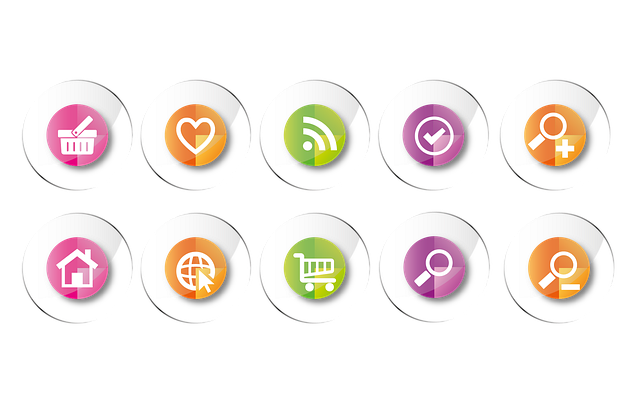In today's digital world, affordable web design powered by social media integration is a powerful tool for businesses to thrive. By incorporating platforms like Instagram, Facebook, and Twitter, companies can create dynamic content, reach global audiences, and gain consumer insights. This strategy boosts online presence, fosters community building, and improves SEO through user-generated content. Small businesses, in particular, benefit from customizable templates and e-commerce capabilities, enabling them to compete effectively with larger brands. Key metrics like engagement rates and reach help measure success, while staying ahead of trends such as mobile-first interfaces and immersive technologies is essential for long-term growth. Case studies show that successful integration leads to increased brand loyalty and conversion rates.
Social media integration is no longer a marketing nice-to-have, but an essential strategy for modern businesses. In today’s digital landscape, connecting your website with social platforms offers immense potential to boost user engagement, expand reach, and drive conversions. This article explores the multifaceted benefits of social media integration, from enhancing user experiences through seamless login to leveraging creative content strategies. We’ll delve into best practices, key performance metrics, and case studies, guiding you towards successful implementations, even for small businesses with budget constraints, by highlighting affordable web design solutions.
Understanding Social Media Integration: Its Importance in Modern Marketing

In today’s digital era, Social Media Integration has become an indispensable tool for businesses and marketers alike. It involves seamlessly incorporating social media platforms into a comprehensive marketing strategy, allowing brands to engage directly with their target audience. By leveraging the power of these platforms, companies can create a more personalized and interactive experience for customers, fostering stronger relationships and driving brand awareness.
The importance of Social Media Integration is evident in its ability to reach a vast global audience at a relatively low cost. With an affordable web design that incorporates social media feeds and sharing options, businesses can enhance their online presence and improve customer engagement. This strategy enables marketers to gather valuable insights into consumer behavior, preferences, and trends, which can then be used to refine marketing campaigns and tailor content accordingly.
Benefits of Integrating Social Media with Your Website Design

Integrating social media with your website design offers numerous benefits, especially for businesses aiming to enhance their online presence and reach a wider audience. One of the key advantages is increased visibility and engagement. By seamlessly incorporating social media feeds, buttons, and sharing options into your web design, you encourage visitors to interact with your content, share it on their platforms, and potentially drive more traffic back to your site. This user-generated content can significantly boost your website’s organic reach.
Furthermore, affordable web design services now allow businesses to leverage social media integration without breaking the bank. Many cost-effective solutions provide customizable options, ensuring your website remains visually appealing and user-friendly while incorporating social media elements effectively. This strategic move not only improves customer engagement but also contributes to better search engine optimization (SEO) by establishing a stronger online presence and fostering a sense of community around your brand.
Affordable Web Design Solutions for Small Businesses: A Focus on Social Features

Small businesses looking to establish a strong online presence often find themselves constrained by budget limitations. This is where affordable web design solutions step in as a game-changer. Many cutting-edge tools and platforms now offer cost-effective ways for startups and small enterprises to create professional websites without breaking the bank. These tools provide customizable templates, drag-and-drop interfaces, and built-in e-commerce capabilities, allowing business owners to build a comprehensive online platform efficiently and affordably.
Integrating social media features into these affordable web design packages further enhances their value. By seamlessly connecting social media accounts, businesses can create an engaging user experience, fostering interaction and building a community. This strategy not only promotes brand awareness but also leverages the power of social proof, encouraging customer engagement and loyalty. With such accessible tools at their disposal, small businesses can now compete in the digital arena, leveraging social integration to establish a robust online identity.
Enhancing User Engagement: Creative Ways to Leverage Social Platforms

In today’s digital era, social media integration offers businesses a powerful tool to enhance user engagement and boost their online presence, especially with affordable web design solutions readily available. By leveraging platforms like Instagram, Facebook, and Twitter, brands can create dynamic and interactive experiences that captivate audiences. One effective strategy is to host contests or giveaways, encouraging users to share content, tag friends, and engage with the brand’s posts. This not only increases visibility but also fosters a sense of community around the business.
Additionally, user-generated content (UGC) is a game-changer. Brands can prompt customers to share their experiences with products or services using specific hashtags, which can then be featured on the company’s social media channels. UGC adds authenticity and variety to the brand’s online narrative, attracting potential new followers and driving engagement. Furthermore, interactive elements like polls, quizzes, and live streams provide real-time interaction, allowing businesses to connect deeply with their audience and adapt their strategies based on user feedback.
The Role of Visuals and Content Strategy in Effective Social Media Integration

In the realm of social media integration, visuals and content strategy play a pivotal role in capturing audiences’ attention and fostering meaningful engagement. Affordably designed web pages that seamlessly incorporate visually appealing graphics, infographics, and high-quality images can significantly enhance user experience. These elements not only make the content more aesthetically pleasing but also facilitate faster comprehension and retention of information. A well-curated visual strategy ensures that your brand’s message is consistently communicated across various platforms, aligning with the unique aesthetics of each channel.
A robust content strategy, integrated with effective use of visuals, allows businesses to tell compelling stories, highlight products or services, and build a strong brand identity. By understanding your target audience and tailoring content accordingly, you can create a cohesive social media presence that resonates with viewers. Affordable web design solutions, when optimized for visual impact, enable smaller businesses to compete effectively on social media while maintaining a professional online image without breaking the bank.
Best Practices for Seamless Social Login and User Experience

Implementing seamless social login can greatly enhance user experience, especially with today’s tech-savvy audience expecting quick and easy access to services. To achieve this, follow best practices such as offering multiple social media options (e.g., Google, Facebook, Twitter) to cater to diverse preferences, ensuring data privacy by clearly communicating what information is being shared, and minimizing the number of steps required for login to avoid user frustration.
Affordable web design should not compromise functionality or security when integrating social media login. Utilize secure protocols like OAuth 2.0 to manage access tokens, enable users to connect without sharing sensitive data directly with third-party platforms, and streamline the registration process by leveraging existing social profiles. Regularly update your platform to keep up with evolving social media APIs and best practices, ensuring a smooth and efficient user journey across all touchpoints.
Measuring Success: Key Metrics for Tracking Social Media Integration Performance

Measuring success is an integral part of any digital strategy, and social media integration is no exception. When evaluating the performance of your social media integration efforts, several key metrics can provide valuable insights. Engagement rate, a primary indicator, measures the level of interaction users have with your content, such as likes, comments, shares, and clicks. This metric is crucial for understanding the appeal and effectiveness of your integrated campaigns.
Additionally, tracking reach and impressions offers a broader perspective. Reach represents the unique number of people who see your content, while impressions count every time it’s displayed. These metrics are essential for affordable web design strategies as they help demonstrate the potential exposure and the overall impact of your social media integration on your target audience.
Staying Updated: Trends Shaping the Future of Web Design and Social Integration

In today’s digital landscape, staying updated on trends is paramount for businesses aiming to maintain a competitive edge in web design and social integration. The rapid evolution of consumer behavior and technology demands that affordable web designs keep pace with emerging trends such as mobile-first interfaces, voice user interfaces (VUI), and immersive experiences like augmented reality (AR) and virtual reality (VR). Brands that integrate these trends effectively not only enhance user engagement but also solidify their online presence.
Social media platforms themselves are continuously innovating to provide seamless integration with web design. Features like live streaming, interactive content, and personalized feeds are reshaping how users interact with digital content. For businesses, this means embracing affordable web design solutions that can effortlessly incorporate these social trends. By doing so, they can leverage the power of social media to drive traffic, foster community, and ultimately boost conversion rates.
Case Studies: Successful Implementations of Social Media Integration Strategies

Successful implementations of social media integration strategies offer valuable case studies for businesses aiming to enhance their online presence and engage with customers. For instance, many e-commerce platforms have seen remarkable success by integrating user-generated content from social media platforms like Instagram and Facebook directly into their websites. This approach not only showcases authentic product reviews and styles but also increases conversion rates due to the added trust and visual appeal.
Another notable example is the integration of live streaming features, popularized by platforms like Twitch and YouTube Live, into corporate websites. This strategy has been particularly effective for brands in the entertainment and education sectors, allowing them to host interactive sessions, answer customer questions in real-time, and foster a sense of community, thereby boosting engagement and brand loyalty. These case studies underscore the potential of social media integration to drive business growth and enhance user experiences, especially when implemented thoughtfully with considerations like affordable web design.
